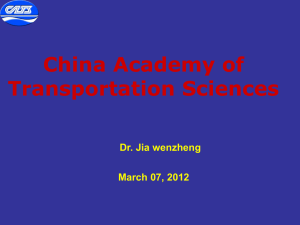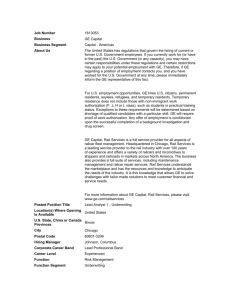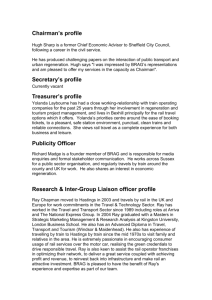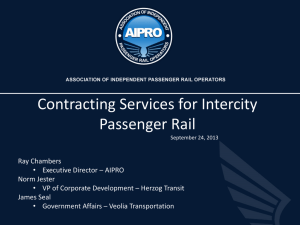build-operate-transfer challenges in asian rail projects
advertisement
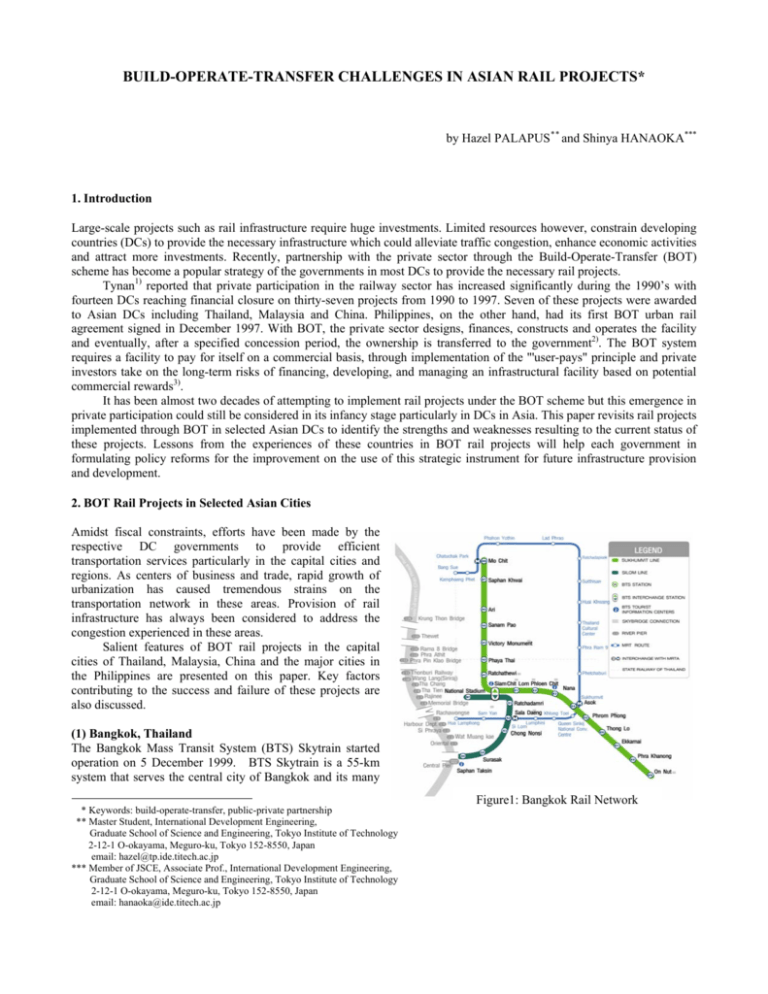
BUILD-OPERATE-TRANSFER CHALLENGES IN ASIAN RAIL PROJECTS* by Hazel PALAPUS ** and Shinya HANAOKA*** 1. Introduction Large-scale projects such as rail infrastructure require huge investments. Limited resources however, constrain developing countries (DCs) to provide the necessary infrastructure which could alleviate traffic congestion, enhance economic activities and attract more investments. Recently, partnership with the private sector through the Build-Operate-Transfer (BOT) scheme has become a popular strategy of the governments in most DCs to provide the necessary rail projects. Tynan1) reported that private participation in the railway sector has increased significantly during the 1990’s with fourteen DCs reaching financial closure on thirty-seven projects from 1990 to 1997. Seven of these projects were awarded to Asian DCs including Thailand, Malaysia and China. Philippines, on the other hand, had its first BOT urban rail agreement signed in December 1997. With BOT, the private sector designs, finances, constructs and operates the facility and eventually, after a specified concession period, the ownership is transferred to the government2). The BOT system requires a facility to pay for itself on a commercial basis, through implementation of the "'user-pays" principle and private investors take on the long-term risks of financing, developing, and managing an infrastructural facility based on potential commercial rewards3). It has been almost two decades of attempting to implement rail projects under the BOT scheme but this emergence in private participation could still be considered in its infancy stage particularly in DCs in Asia. This paper revisits rail projects implemented through BOT in selected Asian DCs to identify the strengths and weaknesses resulting to the current status of these projects. Lessons from the experiences of these countries in BOT rail projects will help each government in formulating policy reforms for the improvement on the use of this strategic instrument for future infrastructure provision and development. 2. BOT Rail Projects in Selected Asian Cities Amidst fiscal constraints, efforts have been made by the respective DC governments to provide efficient transportation services particularly in the capital cities and regions. As centers of business and trade, rapid growth of urbanization has caused tremendous strains on the transportation network in these areas. Provision of rail infrastructure has always been considered to address the congestion experienced in these areas. Salient features of BOT rail projects in the capital cities of Thailand, Malaysia, China and the major cities in the Philippines are presented on this paper. Key factors contributing to the success and failure of these projects are also discussed. (1) Bangkok, Thailand The Bangkok Mass Transit System (BTS) Skytrain started operation on 5 December 1999. BTS Skytrain is a 55-km system that serves the central city of Bangkok and its many Figure1: Bangkok Rail Network * Keywords: build-operate-transfer, public-private partnership ** Master Student, International Development Engineering, Graduate School of Science and Engineering, Tokyo Institute of Technology 2-12-1 O-okayama, Meguro-ku, Tokyo 152-8550, Japan email: hazel@tp.ide.titech.ac.jp *** Member of JSCE, Associate Prof., International Development Engineering, Graduate School of Science and Engineering, Tokyo Institute of Technology 2-12-1 O-okayama, Meguro-ku, Tokyo 152-8550, Japan email: hanaoka@ide.titech.ac.jp commercial, residential and tourist area through the Sukhumvit Line and the Silom Line (Figure 1). Skytrain is operated by Bangkok Mass Transit System Public Company Limited (BTSPCL) as part of their 30-year BOT contract with the government. Fare is based on the distance traveled. Single journey ticket ranges from THB15 to THB40. Based on the company’s annual report4), financial statement showed that the company had a deficit of BHT13,553 million. The loss was a result of increased costs of fare box, increased selling and administrative expenses, interest expenses and lower gain on exchange rate. Recently, a report5) showed that the amount of THB2,399.98 million was gained in terms of the company’s profit/loss owing from the reversal of allowance for diminution in value of project costs over the year. The report also mentioned that passenger numbers falling short of the company’s target were influenced by the sluggish economy resulting from the continually increasing price of oil, the adjustment of fares initially ranging from THB10 to THB40 to the current range of THB15 to THB40 which took effect on 1 March 2008 and the political instability which continues to generally effect the national economy. The devaluation of the Baht in 1997 and the lower ridership than initially predicted combined to create financial problems for the company. As it was falling behind its debt and interest payments, it was then necessary to restructure its debt. However, latest report showed that the company had already secured approval by the Central Bankruptcy Court of the company’s rehabilitation plan on 31 January 2007. The company is in discussions with various investors to raise funds to pay back creditors according to the plan, enabling completion of the process ahead of schedule. (2) Kuala Lumpur, Malaysia Four rail projects in Kuala Lumpur (KL), Malaysia implemented on a BOT basis were considered in this paper (Figure 2). STAR LRT. This is a 27- km rail system and the first rail-based private concession in Kuala Lumpur undertaken by STAR (Sistem Transit Aliran Ringan Sdn Bhd.) as a BOO (build-own-operate) project with a 60-year lease in November 1991 and is composed of 2 phases. Phase 1 starts from Ampang to Sultan Ismail (12 km) which started operation on 16 December 1996. Phase 2 runs from Chan Sow Lin to Sri Petaling which was constructed primarily for the purpose of providing smooth transport services for the spectators of the 1998 Commonwealth Games held in Kuala Lumpur. To compensate for the low density of this line, a 3-km extension northwards of Phase 1, from Sultan Ismail to Sentul Timur, was awarded to STAR which was completed in December 1998. Total construction cost for both Phases 1 and 2 was MYR3.5 billion. Average fare was determined by STAR and the Figure 2: KL Rail Network Ministry of Transport within the range of RM0.75 and RM2.95. Ridership of the line was below expectation which has been insufficient for profitability. System capacity was designed for 500,000 passengers per day but as of 2003, the system has only achieved a ridership of 110,000 passengers per day. PUTRA LRT. This line was established on 15 February 1994 with the Projek Usahasama Transit Ringan Automatik (PUTRA) given a 60-year BOT concession to design, construct and operate a 29-km LRT from Subang Depot via KL Sentral to PUTRA terminal at Taman Melati. The system is considered to be the world’s largest fully automatic driverless system using linear induction motors. It started operation on 1 September 1998. Project cost amounted to MYR4.35 billion. The internationally-recognized Bombardier Consortium comprising of Bombardier Inc. and SNC-Lavalin Inc. are providing all the electrical and mechanical systems, rolling stock and services related to the turnkey project. The system was designed to carry 390,000 passengers per day but as of 2007 the system has reached a ridership of 190,000 passengers per day. After some years of operation, both the STAR LRT and PUTRA LRT faced serious financial difficulties in servicing loans related to construction of infrastructure and purchase of rolling stock6). Low levels of ridership were experienced which could be attributed to high rates of motor vehicle ownership. This could also be due to KL’s lack of complementary policies such as park and ride facilities, an efficient feeder bus system, an integrated program for land use and transport planning as well as car restraint measures such as parking controls and effective road pricing policy regime. A study showed that in November 2001, at the time the Federal government took over the assets of two light rail transit firms; both companies had an unserviced debt of US$1.61 billion7). By bailing out the two failing private light rail transit firms, the government also served as ‘guarantor of last resort’ for debt-laden public transport companies. To provide an integrated public transport service in the Kuala Lumpur metropolitan area, a new public transport company, Rangkaian Pengangkutan Integrasi Deras Sdn Bhd (RAPID KL) fully owned and financed by the Federal Government was established in July 2004. Express Rail Link (ERL).This is a 57-km railway line connecting the main station KL Sentral to the Kuala Lumpur International Airport (KLIA) with the Express Rail Link Snd Bhd (ERLSB) given the 30-year concession to finance, design, construct, operate and maintain the KLIA Ekspres and KLIA Transit and other ancillary activities related to railway services on a BOT basis. Total project cost of the ERL amounts to MYR2.4 billion, financed by a combination of equity holdings and loans from a local financial institution as well as export credits from Germany. KLIA Ekspres and KLIA Transit started operation on 14 April 2002 and 1 June 2002, respectively. Single fare for the whole stretch is MYR35. The target ridership of the system is about 10,000 passengers a day or 20% share of the passengers who use the KLIA. As of August 2007, average daily commuters reached 4,900 for the KLIA Ekspres and 6,660 for the KLIA Transit or a total of 11,560 passengers. To further enhance usage of the system, ERLSB decided to launch a baggage checkout service at KL Sentral which could increase the ridership up to 25% to 30% of travelers using the KLIA. KL Monorail. This is an 8.6-km monorail system aimed at connecting and complementing other urban transportation systems in Kuala Lumpur. It was completed at a cost of RM1.18 billion by the KL Infrastructure Group (KL Infra) under a 40-year BOT concession and became operational on 31 August 2003. On 15 May 2007, KL Infra declared bankruptcy after repeatedly missing loan repayments. On 19 December 2007, the KL Monorail system was taken over by Syarikat Prasarana Negara Berhad (SPNB), a government-owned company under the Ministry of Finance which aimed at improving urban public transport in KL. Since then, KL StarRail Sdn Bhd, a wholly-owned subsidiary of SPNB was appointed to manage the KL Monorail system. The system can handle 3,416 passengers per hour per direction (pphpd). Currently the monorail is at peak capacity, and restricted by the limitations of the signaling system. The system is however designed to accommodate future expansion with the system's stations significantly longer than the current monorail train set allowing ample room for more cars for each monorail train. (3) Beijing, China There are two rail projects in Beijing, China considered in this paper (Figure 3). Beijing Subway, Line 4. This is a 27.69- km subway line with Majialou in Fengtai District as its southern end and Beigongmen of the Summer Palace at the northern end. Total investment of the project is about RMB15.3 billion. Of this amount, about 70 percent (around RMB10.7 billion) will be provided by the Beijing Municipal Government (BMG) to finance land acquisition and civil construction. The remaining 30 percent (around RMB4.6 billion) will be funded through a join venture among Mass Transit Railway Corporation (MTRC), Infrastructure Investment Co. Ltd. and Beijing Capital Group, which will develop and operate the system under a 30-year concession. Fares will be adjusted in accordance with the development of the economy, only the government has the right to decide ticket fees and MTRC which will operate the system will not get any subsidy from the BMG. Civil works and electrical and mechanical (E&M) works are ongoing for the system’s scheduled operation on 30 September 2009. Beijing Subway, Line 8. This is a 4.53 km subway Figure 3: Beijing Rail Network line connecting Beijing’s Olympic Village with Line 10 specifically built for the 2008 Olympic Games and became operational on 19 July 2008. Total project cost amounts to RMB2.5 billion with the Beijing Mass Transit Railway Operation Corp., Ltd given the concession to operate and manage the line. Flat fare for the line with unlimited transfers is RMB2.00. Access was originally restricted to authorized users going to the Olympic venues but since October 2008 the line has been fully opened to the public. Taking into account the other subway lines proposed for Beijing, the needed investment was too heavy to burden for the BMG and thus the participation of private sectors were called. It was also considered that if the BMG continues to act as the sole sponsor of the construction of the subway lines many other projects might have to be further delayed. (4) Metro Manila, Philippines The MRT 3 Project is the first urban rail project in the country applying the Philippine BOT Law (Republic Act 6957) which was enacted in 1990. The 16.9-km line aimed at decongesting EDSA, one of Metro Manila’s main thoroughfares, became operational on 16 December 1999 (Fig. 4). Under a 25-year build-lease-transfer (BLT) agreement with the Department of Transportation and Communications (DOTC), Metro Rail Transit Corporation (MRTC) built the system including the provision of trains. Upon completion DOTC leased the system from MRTC in return for equity rental, debt rental, and maintenance rental payments. Also, under the BLT contract, MRTC is given a guaranteed rate of return on investment of 15 percent a year. This means that the government is obliged to pay the deficit whenever the net income on operations falls short of this percentage. Currently, instead of each passenger paying PHP60 for the entire distance, the passenger pays only PHP15 resulting for the government to pay for the balance of PHP45. The government shells out at least PHP6.8 billion every year to subsidize the operations of the rail system. Besides this subsidy, the government also spends another PHP250 million a month in maintenance fees. The system is capable of Figure 4: Metro Manila Rail Network servicing 600,000 passengers a day but because of the lack of trains, it could only carry 450,000 passengers a day; thus foregoing revenues reaching PHP1.5 million daily given the minimum fare of PHP10 per passenger. As the government can no longer afford to subsidize the train’s operation, on 30 August 2007, the government through the DOTC and the Department of Finance entered into an agreement with the private consortium led by the Fil-Estate group to buyout the BLT contract of the MRTC for US$865 million, ahead of the period stipulated in the concession agreement. 3. Conclusions As presented from the sample cases, private sectors can play a significant role in infrastructure provision and development. Though some of these projects may have encountered difficulties in different stages of implementation, it could be said that without the partnership with the private sectors, these projects may have not been realized as in the case of the Beijing Subway Lines. Looking at the number of projects implemented under the BOT scheme, it could be said that Malaysia has been reaping the benefits of this strategic approach. Forecasting the expected ridership which is the basis of calculating the projected profit has been the common problem of most of the rail projects. Policies should have been made by the government, e.g., in Kuala Lumpur, to integrate the bus-rail services to further enhance the use of public transport. The BOT scheme to be used should also be carefully selected. In the case of the Philippines, the BLT agreement gave the commercial risk, which is normally borne by the private sector, to the government. Considering the government’s limited resources and the huge amount of investment at stake, management of risks associated in all stages of implementation should be given critical focus both by the government and the private sector to ensure success of BOT projects. Risk allocation should be clearly stated in the contract to delineate the roles and responsibilities of each party for each risk. While the emergence of BOT in Asia particularly in the rail sector is still on its early stage, it gave developing countries the opportunity to shift towards project financing while addressing the infrastructure needs of the economy. Experiences on the utilization of BOT should then be constantly revisited for further refinement of policies governing this strategic approach. References 1) Tynan, N., Private Participation in the rail sector-recent trends, Public Policy for the Private Sector, Note No. 186, 1999 2) Menheere, S. and Pollalis, S., Case Studies on Build Operate Transfer, Project Management and Real Estate Development, Delft University of Technology, the Netherlands, 1996 3) Handley, Paul, A critical view of the build-operate-transfer privatisation process in Asia, Asian Journal of Public Administration, 19- 2, pp. 203-243, 1997 4) Bangkok Mass Transit System Public Company Limited, Annual Report 2004-2005 5) Bangkok Mass Transit System Public Company Limited, Annual Report 2007-2008 6) Mohamad, H., Rail transportation in Kuala Lumpur, Japan Railways & Transport Review, 35, 2003 7) Kiggundu, A., Financing public transport systems in Kuala Lumpur, Malaysia: challenges and prospects, Transportation, 36-3, ISSN 0049-4488, Springer Science+Business Media, LLC pp. 275–294, 2009


